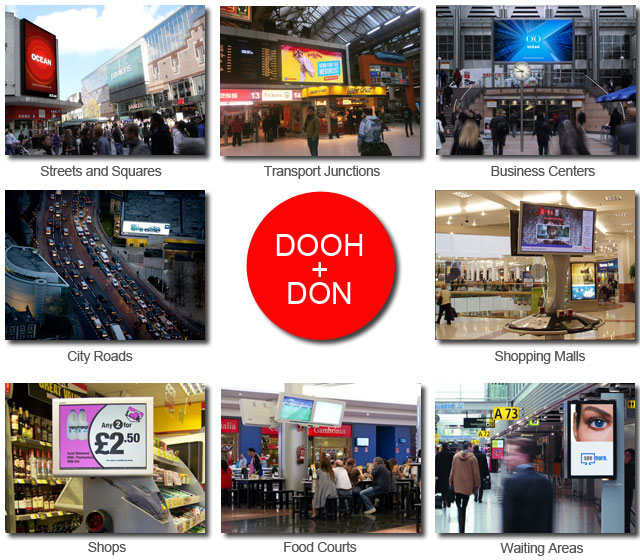Review of Modern Tendencies in DOOH and DON in 2012-2013 - Part 1
The current article is based on the report of Dr. Krylov at the Conference “DigitalOOH: interactive communication with consumers” that was organized by Outdoor media Magazine and its Chief Editor Andrey Galkin - www.outdoor.ru
Keywords are explained at the end of the article.

Complexes DOOH and DON = new digital mass media –
City public TV
The most important global tendencies in the area of Digital OOH (DOOH) and Digital Outdoor Network (DON) are:
- Transition from static to dynamic imaging.
- Significant improvement in image quality on both indoor and outdoor advertising screens and resulting increase in the number of digital advertising screens.
- Introduction of new DOOH functions: these complexes are no longer purely advertising screens but an essential part of urban OOH informational environment with news and emergency broadcasts.
- Gradual merging of individual screen networks that leads to creating new digital mass media – public city TV.
- Implementation of new technologies of secure broadcasting and secure log reports (customers no longer receive photo reports but extensive digital reports of actual campaign conducted).
- Innovative forms of digital messaging and video presentations of outdoor advertising, including interactive methods of attracting customers.
- Informational support to public events in political, social or legal spheres, including local news and PA reporting in various formats.
The above tendencies will be discussed in the pages below:
1. Transition from static to dynamic imaging
Digital Outdoor urban informational environment is actively developing all around the globe. In most developed cities such as Beijing, Shanghai, Hong Kong, Guangzhou, Tokyo, London, New York, St Petersburg, Yekaterinburg, Tyumen, Kaliningrad, Yuzhno-Sahalinsk, San Paolo, Cape town etc. the tendency to replace static advertising with dynamic imaging is very prominent.
However another approach to presentation of materials on digital screens exists currently in some regions and cities, including Moscow and some southern US states. For Moscow especially this is a step backwards since there is no doubt that dynamic imaging is more progressive compared to static picture presentation. One reason maybe the outdated control systems and inability to upgrade old communication equipment. What is more confusing is the official rhetoric promoting static advertising under the guise of public safety.
 |
 |
| Dynamic LED video screens in London | |
2. Significant improvement in image quality and increase in the number of digital screens
Recent breakthroughs in LED and informational technology allowed to significantly improve image quality of dynamic video systems. The Internet entered all spheres of life, especially in urban areas. New generations of communication systems ensure reliable control and broadcast of video over vast distances. Installation of public video screens turned from a mere trickle to a powerful surge. Falling prices on screens made them attractive to advertisers. As a result, more and more sites of traditional outdoor advertising are being converted to digital formats around the world. Transport and transport junctures are filled by screens. Over the period of one day people going to work and returning home encounter dozens of large and small screens routinely. Digital advertising out-of-home became a fast feature of our everyday lives.

Transport junctures, metro entrances, streets –
there digital screens are everywhere you turn
3. Introduction of new DOOH functions as part of urban informational environment
This tendency became apparent only in 2011-2012. The reason new functions are introduced maybe explained by fast maturing technology and the need of authorities to effectively use all informational resources within their grasp. When LED screens were unique and fairly unusual, operators were mostly left alone. But with the number of screens growing, a new mass media started to emerge. The authorities everywhere around the world are quick to claim their share of the new media.
The existing screen networks are not allowed to function as only advertising carriers: they are considered part of urban environment and therefore must serve as OOH news and informational announcement boards. The opportunity to use screens for the benefit of the public was first utilized in Japan, China and Korea. Later, the authorities in the USA adapted advertising screens for a number of national security informational programs. In Russia an “Oksion” program was financed to run state-approved announcements on some screen networks, including the largest one in St. Petersburg.
The most noticeable projects in the area were implemented on the networks of the following companies:
- USA: Clear Chаnnel, Lamar, Titan Outdoor.
- China: ChinaVision, Phoenix LED Media Network, China Gaz Oil.
However there are numerous exceptions. In some southern states of the USA (especially in cities of San Francisco and Los Angeles) and in Moscow, most advertising digital screens are not merged and exist as separate structures without unified control. This prevents digital outdoor systems from being utilized by the authorities for the public good.

Digital systems as an essential part
of urban infrastructure
4. Gradual merging of individual screen networks
This tendency was slow to emerge which was mostly due to a insignificant number of digital screens in various cities. However around 2010 first attempts were made to unify individual screens and small networks in the USA, Japan and Hong Kong. China with its well developed LED screen industry embarked on this experiment on the massive scale. Souther cities of China and Hong Kong were the first to shape a new media format for the public outdoor TV in urban environment. In 2012, this tendency became evident in Britain, probably boosted by the Olympic Games and massive installation of LED screens. Russia is still lagging behind but major changes are expected in 2013-14.

Informational and advertising digital systems
in modern cities





